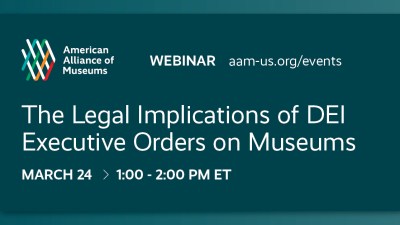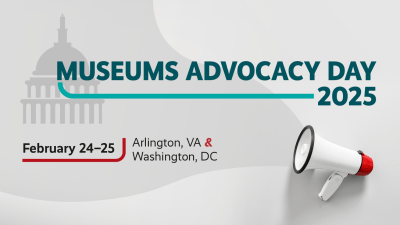
This article originally appeared in the May/June 2022 issue of Museum magazine, a benefit of AAM membership.
How can museums thrive in the next era of private cultural philanthropy?
We are living in the era of impact. Amid a profound reckoning in society, we are reexamining what we value, whom we trust, and how we collaborate. The next era of philanthropy is being shaped by the individuals and organizations spearheading new models for sustainable impact.
In this new landscape, we are seeing household giving decrease, student debt balloon, and trust in nonprofits—and institutions in general—dwindle. Studies by IMPACTS Experience show that the cultural sector is experiencing negative substitution, a globally occurring phenomenon wherein the number of people who profile as active visitors leaving the market outpaces the number of people who profile as active visitors entering the market. The need to grow our cultural audiences was critical even before the pandemic further changed earned-income and attendance patterns.
Simultaneously, we are experiencing the largest intergenerational wealth transfer in history: it is estimated that about $60 trillion will be transferred over the next few decades. According to A Look at Millennial Wealth by WealthEngine and Coldwell Banker Global Luxury, there are over 600,000 millennial millionaires in the United States, and their wealth is expected to increase by almost 5 percent by the end of this decade.
These heirs and new wealth creators represent a significant portion of the next era of cultural funders. This philosophically aligned cohort, a psychographic stretching across several age brackets and demographics, aims to create more equity and immense social impact through transformational giving. They are asking big questions: How can I drive progress in communities? How can I use my giving to solve global challenges? How can I create deeper and broader impact? How can I create more equitable and democratic systems?
It is more critical than ever to update our models to align with this next era of philanthropy. The arts sector must be open to fundamental change, and it must prove its social value and impact, meaning, and relevance. How the industry responds will determine if we survive and thrive.
The Trend Lines
When we launched Arts Funders Forum (AFF) in 2019, we were three months away from the largest global pandemic in a century. However, as a media, research, convening, and advocacy platform dedicated to expanding private giving for the arts, we were already aware of three cultural truths that would have consequences during this period:
- Arts giving is stagnant or decreasing, representing only 4 percent of total charitable giving.
- In the midst of this massive wealth transfer, those inheriting the wealth do not consider the arts essential, and they prioritize giving to other sectors that better demonstrate their impact in driving social progress.
- These heirs and new wealth creators increasingly see philanthropy through a social justice lens—they prioritize advancing social, racial, and environmental justice; equity; and democracy.
Throughout the pandemic, citizens around the globe turned to art, music, and creativity to stay sane and safe. Some assumed that this renewed appreciation of the arts would turn into financial support. But there was obviously a disconnect, and the proof is in the numbers.
According to the 2021 edition of Giving USA: The Annual Report on Philanthropy, overall charitable giving in the US in 2020 broke records. In a year when every industry needed to make its case for survival, gifts from individuals, corporations, bequests, and foundations totaled $471.44 billion. But, while seven of the nine charitable sectors saw growth, giving to the arts, culture, and humanities sector (at $19.47 billion in 2020) had an estimated year-over-year, inflation-adjusted decline of 8.6 percent. For another year, giving to the arts—a more than $800 billion industry, representing over 4 percent of America’s GDP—yet again remained stagnant at 4 percent of total American giving. This is staggering when you consider that arts and culture represent a greater portion of the economy than transportation, tourism, and agriculture.
AFF has found consensus among surveyed funders and cultural leaders alike that the sector has not done a good job of articulating its social value to society. Arts and culture are considered, as one interviewee said, a “nice to have, not a must have”—a status thing, not a necessary thing. A slow-moving crisis for decades, the events of the past two years have obviously accelerated these trends. We are now confronting a rapidly increasing threat to the traditional cultural funding model.
During my 20 years as an arts fundraiser and a cultural philanthropy advisor, I have watched this generational change unfold. Heirs to the families that built or sustained arts institutions for decades express disinterest in continuing the legacy in a significant way. New wealth creators across age brackets tell me they do not think giving to the arts sector is a good investment. Why? They do not see how arts organizations are contributing to a better world, making a profound impact on their communities, or serving anyone but the elite.
New Ways of Working
This next era of donors and audiences wants to see profound change in the sector. It’s time to listen more deeply and collaborate to put their ideas into action. They want to give their treasure and their time by rolling up their sleeves and being involved in program creation. They want to use their professional, personal, and entrepreneurial skills to help institutions drive change in their communities. They largely do not care about lavish galas or seeing their names on the walls of museum galleries or concert halls. This differentiates them from their predecessors and therefore changes how the sector must define its impact, tell its story, and engage new audiences to cultivate a more democratic base of support. Following are some best practices for making those changes.
Acutely listen to audiences. Relationships do not work if they are one-sided. Listen to what your audiences are telling you about how to best serve them and drive impact. Meet the community where it is. Younger generations are used to their opinions being solicited, so create an atmosphere of co-authorship and collective visioning. Recognize that an institution is responsible to its largest group of stakeholders—its community.
Clarify the narrative by articulating the need and impact. Younger audiences engage with organizations that represent their values and serve as drivers, catalysts, and resources to solve challenges. It is vital to position the arts institution as a conduit to the cause, clearly defining the need it is addressing. The mission must be authentically carried out by the program, and the program should have a measurable impact on communities. Evaluate, articulate, and demonstrate how you are driving change.
Redefine storytelling and tell stories honestly. Who is telling the story is just as important as what the story is. Your audiences, ambassadors, and advocates can best describe how the organization makes an impact in the community. Institutions need to empower communities and provide them with the tools to share their narratives.
Diversify your funding streams and cultivation practices. Next-era philanthropists want alternatives to the traditional nonprofit model. Embrace practices such as impact investing; direct artist support pipelines; peer giving collectives; and social enterprise, which maximizes a museum’s social impact to more effectively partner with private (and public) investors. As funders think about gifts of real estate, time, and other forms of capital, offer them hands-on experiences with programs and communities to clarify what is needed to successfully drive long-term sustainability and impact.
Invest in community building. Relevance in the 21st century is about driving impact and building communities. Period. Investing in communities, local arts ecosystems, and cultural practitioners through an interdisciplinary approach of cultural practice and social justice efforts will rally the cultural ecosystem and next-era donors alike and broaden support beyond traditionally engaged constituencies.
Double down on transparency. We must make the industry more accessible and permeable. The art world is opaque and intimidating, and there is a perception that it is only for the elite. Nonprofits should communicate openly about funding models, programming decisions, board governance, and much more in order to solidify trust.
Foster holistic diversity and access. It is imperative that organizations engage in self-reflection and self-learning, required processes for change. Admit that you are striving to be better, even as you have setbacks. Be accountable to equity and diversity practices across the organization, from budget to programming to staffing. Take inventory of your endowed funds and prioritize ESG (environmental, social, and governance) values; next-era funders want to invest in organizations that themselves invest consciously with an eye to social and environmental justice.
Create more—and more effective—partnerships and collaborations across industries. Partnerships across institutions, funding entities, and community networks leverage philanthropic possibilities and democratize the traditional base of supporters. Look outside the traditional models, apply for funding as a collective, create collective boards and ambassadorships, and leverage other institutions’ strengths, communities, and audiences to drive greater impact.
As emerging philanthropic leaders begin to make era-defining decisions, bringing an increased focus on impact-driven models of investment, they can co-create a sustainable, equitable cultural sector that expands economic opportunity, heals communities, strengthens democracy, and inspires creative solutions to global challenges. Work with them to do so.
What Do New Philanthropists Want?
Data uncovered by Arts Funders Forum’s ongoing research program illuminates concerning trend lines in cultural philanthropy. Wealth transfer heirs and new wealth creators have a very different view of philanthropy than their predecessors.
They are skeptical about the power of the arts to drive change and solve our biggest challenges.
They care about how they give, not just what they give.
They want increased collaborations and partnerships within philanthropy.
They want more transparency about the destination and impact of their gifts.
They seek specific, measurable impact.
They want new models of investment, such as impact investing, peer giving collectives, and direct artist support.
Resources
Arts Funders Forum (AFF) research
artsfundersforum.com/insights
AFF “Remake the Model” series
artsfundersforum.com/events
nico wheadon, Museum Metamorphosis, Cultivating Change Through Cultural Citizenship, 2022








Comments